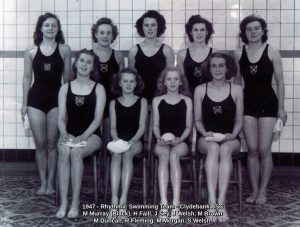The United States and Canada have played a leading role in the development of synchronised swimming. During the 1920s, groups of American and Canadian women developed aspects of life-saving and graceful swimming into artistic activities and teams of women gave “flotation” or “formation” displays.
They moved up and down the pool or formed a circle to make kaleidoscopic patterns.
Each time the Bath-Master blew his whistle the pattern changed shape.
The Tarpoon Club of Chicago made one of the first attempts to present aquatic movement synchronised to the beat of music in the Lagoon Theatre in 1933.
This marked the beginning of synchronised (artistic) swimming as we know it today.
Synchro began to take off in American colleges as Katherine ‘Kay’ Curtis, from the University of Chicago, conjured up the idea of combining water acrobatics with music.
After experimenting with various diving actions and stunts in the water, Curtis started one of the first water ballet clubs at the University of Chicago, where the team began executing strokes, tricks and floating formations.
In 1934, she took a group of 60 swimmers, labelled “The Modern Mermaids”, to participate at the 1934 “Century of Progress” World Fair in Chicago. It was here that the sport’s name as we know it today was first addressed to a wide audience, when former swimmer and Olympic gold medallist Norman coined the term “synchronised swimming”.
From there, the sport gained Hollywood popularity when American film star Esther Williams, a former swimmer, performed routines in several movies known as aquamusicals in the 1940s and 1950s such as Bathing Beauty (1944), Neptune’s Daughter (1949) and Million Dollar Mermaid (1952).
The competitive aspect continued to develop around the same time when Frank Havlicek, a student of Curtis, drew up a set of rules.
Curtis also had lit a torch in her honour at the 1952 Olympics, at which the sport was first demonstrated.
Aquatic displays of one kind or another had always been used at galas to relieve the monotony of long sessions of speed swimming – however
after World War II, “formation swimming” lost its impetus and displays disappeared from Gala Programmes as Speed Swimming increased in popularity.
A competitive structure emerged, largely of compulsory figures and strokes, but it also included a solo routine performed to music and duet and team routines were added by 1950.
In Scotland, displays of the various strokes and selected skills by teams of female swimmers had been given at Club Galas since the late 1890s, but it was not until the 1960s that recognised figures, synchronised to music, were introduced.
It was 1963 before the S.A.S.A. established a committee to ‘explore the question of synchronised swimming’.
Unfortunately, no meetings were held and the Association gave the sport little attention, however at Club level, however, there were some enthusiasts.
Mary Black at Clydebank A.S.C. showed a particular interest and in the early 1960s, attended several A.S.A. Synchronised Swimming Courses at Crystal Palace, where she was able to study the latest techniques and developments and forge links with English coaches and teachers.
She brought a lot of new ideas back to Clydebank and tried them out with her “rhythmic swimming team”.
The Association resurrected its interest in synchronised swimming in 1968, partly because of an expanding grass-roots interest and partly because it wanted to add a little variety to some of the “rather light” and “monotonous” swimming sessions at the 1970 Commonwealth Games.
Arrangements were made to train a team for the Games and a Synchronised Swimming Committee was constituted to organise and promote the discipline.
Mary Black was asked to take charge of both and her “synchronised swimming girls” trained on a regular basis and gave some delightful performances at the Games.
Initially, the Synchronised Swimming Committee concentrated on arousing interest, teaching technical skills and training Examiners and Judges.
In 1969, Margo McGrath and Carol Redmond, World Duet Champions, were invited to Glasgow and gave a memorable performance at Drumchapel Pool. Fifty seven people attended the first National Course at Tulliallan Castle in 1969 and it became an Annual event.
Despite first appearing in the World Championships in 1973, synchronised swimming was not officially included in the Olympics until 1984, in Los Angeles, so Scotland was not alone in the slow rate of acceptance and popularity from Club to Elite level.
By 1975, there were enough proficient performers around to organise some competitions and in 1976, a trial Inter-Club event was arranged and the following year it became an Annual event.
Initially for holders of Award Grades 1 & 2, in 1978 Grades 3 & 4 were added. At the same time an Inter-Club Championship for the Mary Black Rosebowl was introduced.
The 1980s witnessed growth on all fronts. There was: a steady increase in participation with new clubs being formed, improvements in technical standards, an increase in the number of qualified teachers, the growth in competition and improvements in international performance and in 1985, the Scottish Age Group Championships were introduced.
Today, synchronised swimming is a widely-known and popular sport thanks to its continued presence at the Olympics, World and European Championships. In 2014 FINA announced that men would be allowed to compete again, starting at the 2015 World Aquatics Championships, in mixed-pair events.
In Scotland, the sport is continuing to develop and this growth continually shows at the Scottish National & Age Group Open Synchronised Swimming Championships, with unprecedented coverage for synchro in Scotland, including live video and photo updates on social media and exclusive highlights footage. This growth was boosted by the 2018 European Championships staged in Glasgow.
The latest subtle development/change is to the name of the aquatic discipline, which is now known as “Artistic Swimming” to recognise a skillset wider than just synchronisation to music !


